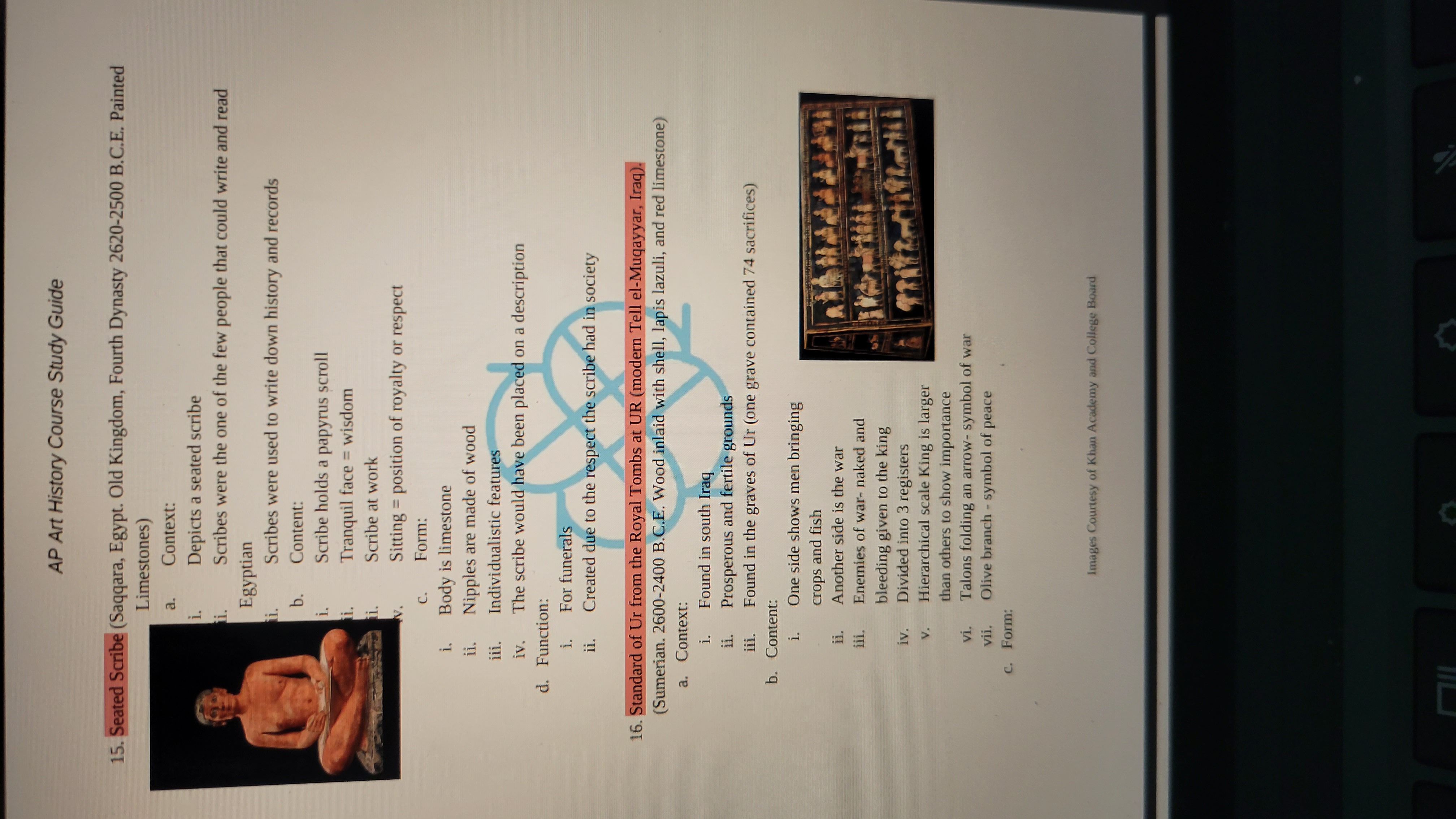AP Art History – Ancient Mediterranean & Egypt Vocabulary
1/24
Earn XP
Description and Tags
25 vocabulary flashcards summarizing key artworks, materials, techniques, and stylistic terms from the student’s Ancient Mediterranean & Egyptian art history notes.
Name | Mastery | Learn | Test | Matching | Spaced |
|---|
No study sessions yet.
25 Terms
Palette of King Narmer
Predynastic Egyptian ceremonial greywacke palette (c. 3000 BCE) celebrating the unification of Upper & Lower Egypt; used for grinding cosmetics, later buried as a votive object.
Statues of Votive Figures
Gypsum stand-in worshipper statues (Sumerian, 2900-2600 BCE) with huge inlaid eyes and clasped hands, placed in shrines to pray perpetually on donors’ behalf.
White Temple and its Ziggurat
Sumerian mud-brick raised platform (Uruk, 3500-3000 BCE) with tripartite plan and white-washed temple dedicated to sky-god Anu; served combined religious and civic functions.
Stele of Hammurabi
Basalt monument (Babylon, 1792-1750 BCE) bearing 300+ cuneiform laws beneath a high-relief scene of Hammurabi receiving authority from sun-god Shamash.
Standard of Ur
Small Sumerian wood box (2600-2400 BCE) inlaid with shell, lapis lazuli, and red limestone; war and peace registers use hierarchical scale to glorify the king.
Seated Scribe
Painted limestone Old Kingdom statue (Saqqara, 2620-2500 BCE) with realistic body and inlaid eyes, honoring literate elite; placed in tomb as a funerary figure.
Great Pyramids of Giza & Great Sphinx
Three 4th-dynasty pyramids (2550-2490 BCE) for Khufu, Khafre, Menkaura and a colossal limestone sphinx; royal tomb complexes aligned to cardinal points.
King Menkaura and Queen
Old Kingdom greywacke pair statue (2490-2472 BCE) showing pharaoh and consort striding forward; idealized yet individualized to assert divinity and marital unity.
Mortuary Temple of Hatshepsut
New Kingdom rock-cut terraced temple at Deir el-Bahri (1473-1458 BCE) with colonnades and kneeling granite statues; served as funerary cult site for the female pharaoh.
Temple of Amun-Re and Hypostyle Hall
Vast sandstone sacred precinct at Karnak (begun 1550 BCE; hall c. 1250 BCE) with axial plan, pylon gateways, clerestory-lit forest of columns honoring Egypt’s chief god.
Akhenaton, Nefertiti, and Three Daughters
Amarna-period limestone sunken-relief (1353-1335 BCE) depicting royal family beneath Aten’s rays with ankhs, expressing monotheistic shift and intimate court style.

Tutankhamun’s Innermost Coffin
Solid gold anthropoid sarcophagus (1323 BCE) inlaid with semiprecious stones, crook & flail, and protective deities; ensured pharaoh’s safe journey to afterlife.
Last Judgment of Hu-Nefer
Painted papyrus vignette from Book of the Dead (1275 BCE) showing heart-weighing by Anubis, presentation to Osiris, and spells guiding the scribe to eternal life.
Lapita Terra-cotta Fragment
Pacific clay shard (c. 1000 BCE) decorated by dentate stamping; once part of a food-storage vessel exchanged among Lapita peoples, evidencing early Oceanic trade.
Greywacke
Hard, dark sandstone favored by Egyptians for high-status sculptures (e.g., Menkaura group, Narmer Palette) because of its durability and fine grain.
Ziggurat
Stepped mud-brick platform with sloping sides supporting a temple; focal point of Mesopotamian city-states for religious, political, and economic activities.
Hierarchical Scale
Artistic convention in which the most important figure is shown larger than others, as on the Standard of Ur or Narmer Palette.
Bas-relief
Shallow carving where figures barely project from background, used on stelae like Hammurabi’s Code and Amarna family scene.
Hypostyle Hall
Large interior space whose roof is supported by many columns; Karnak’s hall employs clerestory lighting to evoke divinity.
Tripartite Plan
Architectural layout with a central rectangular hall flanked by smaller rooms or aisles, typical of the White Temple at Uruk.
Ankh
Egyptian hieroglyphic symbol for life; appears terminating Aten’s rays in Amarna reliefs to show divine breath bestowed on the royals.
Crook and Flail
Paired scepters held by pharaohs (e.g., Tutankhamun’s coffin) symbolizing kingship: crook for shepherding people, flail for fertility and discipline.
Dentate Stamping
Lapita ceramic technique of pressing comb-like tools into wet clay to create repeating geometric motifs.
Clerestory Lighting
Admission of natural light through high windows above lower rooflines, illuminating Karnak’s hypostyle hall.
Axial Temple
Structure organized along a straight longitudinal axis with symmetrical spaces, seen in Egyptian temple complexes like Karnak and Hatshepsut.